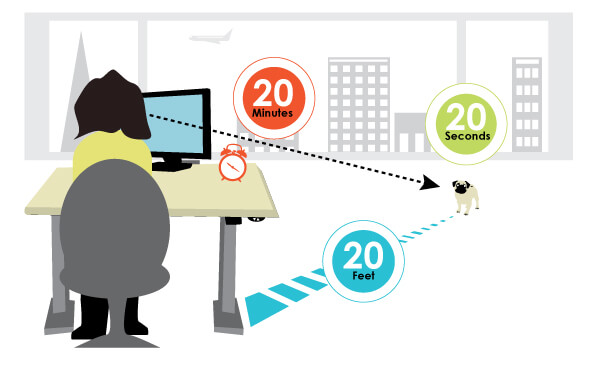Taking care of your eyes is just as important as caring for your overall health. In fact, a regular vision exam is not just about seeing clearly—they can reveal much more, including systemic health conditions such as diabetes, high blood pressure, autoimmune diseases, and more.
Regular checkups will not only let you detect it earlier but also prevent potential vision loss. But how often should you schedule your vision exam?
The frequency depends on different factors such as age, lifestyle, health, family history and other. In this blog, we’ll break it down for you.
1. Vision Exam for Children
Did you know that 20% of children struggle to read because of vision issues? Since 80% of learning is visual, regular eye exams are key to ensuring academic success.

According to the American Optometric Association (AOA):
- First eye exam: At 6 months old.
- Second exam: At 3 years old.
- Before starting school: Around 5 or 6 years old.
- School-age: Every 1 to 2 years, or more frequently if vision correction is needed.
At that age level, a regular vision exam is very important and will help in identifying issues such as nearsightedness (also known as Myopia )
, farsightedness (Hyperopia), astigmatism.
Children might also have a bigger percentage in developing digital eye strain due to long hours on their digital devices, leading to blurry vision, headaches, and fatigue.
Regular vision exams can also help identify other issues than visual clarity more related to eye health and development such as amblyopia (lazy eye) or strabismus (misalignment if the eyes) which might have a bigger chance to be treated when caught early.
Vision therapy can also address issues like trouble concentrating, skipping lines while reading, or writing difficulties.
2. How often should a Teen or Young Adult (Age 13-39) get his Vision Exam
For teens and young adults without vision problems, a vision exam every 2 years is sufficient. However, if you wear contact lenses or eyeglasses, an annual vision exam is recommended to ensure their prescriptions are up-to-date and make sure there are no added complications such as dry eyes or infections for example.

Have you ever heard of the 20-20-20 rule? As a young adult, you have a fast-paced or screen heavy lifestyle which can lead to digital eye strain. Our qualified optometrist can advise of ways to reduce it and keep an eye on your vision:
Every 20 minutes look at an object 20 feet away for at least 20 seconds.
Regular exams can also detect silent conidtions like Glaucoma, which may not show symptoms but can lead to Vision Loss.
3. Vision Exam Guidelines for Adults (Ages 40-64)
Around 40, many people start noticing changes in their vision especially for near work such as reading.
Reading glasses or multifocal lenses, becomes necessary in that case, since Presbyopia is a natural age-related decline in near vision.

Adults in this group should have a vision exam every 1 to 2 years if they do not usually wear glasses or contact lenses.
In that age group, you are also at high risk for vision conditions such as cataract, glaucoma, AMD (age related macular degeneration), where a comprehensive vision exam can help in monitoring these risks. In that case, intraocular pressure, retinal health and lens clarity will be evaluated.
It can also help detect systemic conditions like diabetes and hypertension early.
4. Vision Exam for Seniors (Ages 65 and Older)
For seniors, an annual vision exam is strongly recommended.
The risk of developing conditions like glaucoma, cataract, AMD increases as we age. Early detection and preventions are key to effective management.
5. I’m a Contact Lens Wearer how often should I get a Vision Checkup
Contact lens wearers should also have an annual vision exam to ensure proper lens fit (since the cornea can change over time), prescription accuracy and eye health. Over time, lens material and design might also need to be changed for better comfort and oxygen permeability.
Our optometrist can also guide you on proper usage, hygiene, and best lens types (daily vs monthly). We can also teach new wearers in our shops on how to apply them and remove them.
NB: You should consider that glasses prescriptions might differ from your contact lenses so make sure to have an exam for your lenses.
Running out of Contact lenses ?
6. Recommendations for Individuals with Chronic Health Conditions
Those with diabetes (leading cause of blindness), hypertension, or autoimmune diseases should have their eye exams at least once a year. These conditions can affect the blood vessels in the retina, leading to complications like diabetic retinopathy or hypertensive retinopathy, which can severely impact vision.
Regular vision exams can also help monitor side effect due to certain medications that can impact the eye health.
Our Vision Rehabilitation optometrists and ophthalmologists can work together to create a more holistic approach to manage these effects.
Eyecare is Selfcare!
Vision exams aren’t just for correcting your eyesight—they’re a preventive care for your overall health.
By scheduling your regular check-ups, our professional optometrists can detect and address vision issues early, ensuring a better quality of life.
#LoveYourEyes and give them some extra attention. Enhance your Vision and safegard your future by combining regular exams with healthy habits like wearing UV-blocking sunglasses , eating a balanced diet, and practicing good screen hygiene.
Our records show that it’s time for your annual vision Exam.


 Connect with us!
Connect with us!